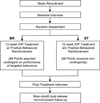Psychosocial Functioning Among Inmates in Prison-Based Drug Treatment: Results from Project BRITE
- PMID: 23626504
- PMCID: PMC3634718
- DOI: 10.1007/s11292-012-9169-5
Psychosocial Functioning Among Inmates in Prison-Based Drug Treatment: Results from Project BRITE
Abstract
Objective: To assess the impact of a positive behavioral reinforcement intervention on psychosocial functioning of inmates over the course of treatment and on post-treatment self-reported measures of treatment participation, progress, and satisfaction.
Method: Male (n = 187) and female (n = 143) inmates participating in 12-week prison-based Intensive Outpatient (IOP) drug treatment were randomly assigned to receive standard treatment (ST) or standard treatment plus positive behavioral reinforcement (BR) for engaging in targeted activities and behaviors. Participants were assessed for psychosocial functioning at baseline and at the conclusion of treatment (post-treatment). Self-reported measures of treatment participation, treatment progress, and treatment satisfaction were also captured at post-treatment.
Results: The intervention affected female and male subjects differently and not always in a way that favored BR subjects, as compared to the ST subjects, most notably on measures of depression and criminal thinking.
Conclusions: Possible explanations for the results include differences in the male and female custody environments combined with the procedures that study participants had to follow to earn and/or receive positive reinforcement at the two study sites, as well as baseline differences between the genders and a possible floor effect among females on measures of criminality. Limitations of the study included the inability to make study participants blind to the study conditions and the possible over-branding of the study, which may have influenced the results.
Keywords: Behavioral Reinforcement; Prisoners; Psychosocial Functioning; Substance Abuse; Treatment.
Figures
Similar articles
-
Developing and implementing a positive behavioral reinforcement intervention in prison-based drug treatment: Project BRITE.J Psychoactive Drugs. 2011 Sep;Suppl 7:40-50. doi: 10.1080/02791072.2011.601990. J Psychoactive Drugs. 2011. PMID: 22185038 Free PMC article.
-
Male methamphetamine-user inmates in prison treatment: during-treatment outcomes.J Subst Abuse Treat. 2010 Mar;38(2):141-52. doi: 10.1016/j.jsat.2009.08.002. Epub 2009 Oct 3. J Subst Abuse Treat. 2010. PMID: 19801177 Free PMC article.
-
Socio-demographic characteristics as correlates of psychological distress.Int J Prison Health. 2018 Sep 10;14(3):210-219. doi: 10.1108/IJPH-10-2017-0042. Int J Prison Health. 2018. PMID: 30274561
-
Attention Deficit Hyperactivity Disorder (ADHD) among longer-term prison inmates is a prevalent, persistent and disabling disorder.BMC Psychiatry. 2010 Dec 22;10:112. doi: 10.1186/1471-244X-10-112. BMC Psychiatry. 2010. PMID: 21176203 Free PMC article. Clinical Trial.
-
The effects of the growing pro-social program on cognitive distortions and early maladaptive schemas over time in male prison inmates: A randomized controlled trial.J Consult Clin Psychol. 2017 Nov;85(11):1064-1079. doi: 10.1037/ccp0000247. J Consult Clin Psychol. 2017. PMID: 29083222 Clinical Trial.
Cited by
-
Effectiveness of Using Incentives to Improve Parolee Admission and Attendance in Community Addiction Treatment.Crim Justice Behav. 2015 Oct;42(10):1008-1031. doi: 10.1177/0093854815592914. Epub 2015 Jul 10. Crim Justice Behav. 2015. PMID: 28331241 Free PMC article.
-
Pharmacological interventions for drug-using offenders.Cochrane Database Syst Rev. 2015 Jun 2;2015(6):CD010862. doi: 10.1002/14651858.CD010862.pub2. Cochrane Database Syst Rev. 2015. PMID: 26035084 Free PMC article.
References
-
- Bandura A. Principles of behavior modification. New York: Holt, Rinehart and Winston; 1969.
-
- Chatham LR, Hiller ML, Rowan-Szal GA, Joe GW, Simpson DD. Gender differences at admission and follow-up in a sample of methadone maintenance clients. Substance Use & Misuse. 1999;34(8):1137–1165. - PubMed
-
- Derogatis LR, Melisaratos N. The brief Symptom Inventory: An introductory report. Psychological Medicine. 1983;13:595–605. - PubMed
-
- Dutra L, Stathopoulou G, Basden SL, Leyro TM, Powers MB, Otto MW. A meta-analytic review of psychosocial interventions for substance use disorders. American Journal of Psychiatry. 2008;165(2):179–187. - PubMed
Grants and funding
LinkOut - more resources
Full Text Sources
Other Literature Sources

